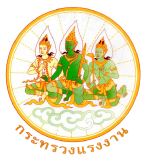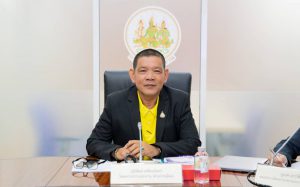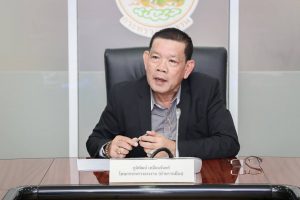นายภูมิพัฒน์ เหมือนจันทร์ โฆษกกระทรวงแรงงาน เปิดเผยว่า นายพิพัฒน์ รัชกิจประการ รมว.รง. ติดตามสถานการณ์ด้านแรงงานอย่างใกล้ชิด โดยได้รับทราบรายงานสถานการณ์กำลังแรงงานของไทย ณ สิ้นเดือน ม.ค.2567 ว่า จำนวนผู้มีงานทำของไทยอยู่ที่ 39.13 ล้านคน จากจำนวนประชากรวัยแรงงานที่มีอายุ 15 ปีขึ้นไปทั้งหมด 58.18 ล้านคน คิดเป็นร้อยละ 66.52 หรือกล่าวอย่างง่ายว่าประชากรวัยทำงาน 100 คน จะมีผู้ที่อยู่ในกำลังแรงงานประมาณ 67 คน แบ่งเป็น ผู้มีงานทำภาคเกษตร 10.38 ล้านคน และผู้มีงานทำนอกภาคเกษตร 28.75 ล้านคน โดยอุตสาหกรรมที่มีการจ้างงานขยายตัวสูงสุด 3 อันดับแรก เมื่อเทียบกับเดือน ธ.ค.2566 ได้แก่ การทำเหมืองแร่ และเหมืองหิน ร้อยละ 128.45 ไฟฟ้า ก๊าซ ไอน้ำ และระบบปรับอากาศ ร้อยละ 28.44 และศิลปะ ความบันเทิง และนันทนาการ ร้อยละ 24.95
สำหรับจำนวนผู้ว่างงาน ณ สิ้นเดือน ม.ค.2567 มีประมาณ 4.32 แสนคน หรือคิดเป็นอัตราการว่างงาน ร้อยละ 1.09 ซึ่งถือเป็นอัตราที่ต่ำมาก เมื่อเปรียบกับหลายประเทศ เช่น ญี่ปุ่นมีอัตราการว่างงาน ร้อยละ 2.37 เกาหลีใต้ ร้อยละ 3.02 และสหรัฐอเมริกา ร้อยละ 3.66 โดยในปี 2566 กองทุนการเงินระหว่างประเทศ หรือ IMF ได้จัดอันดับให้ประเทศไทยมีอัตราการว่างงานต่ำที่สุดในโลก อย่างไรก็ตาม รมว.รง.ย้ำว่าจะต้องไม่ทอดทิ้งคนกลุ่มนี้ แม้จะมีจำนวนไม่มากนัก โดยได้กำชับให้ 5 เสือแรงงานทุกจังหวัดทั่วประเทศลงไปติดตามปัญหาอย่างทั่วถึง
“ท่าน รมว.พิพัฒน์ให้ความสำคัญกับการส่งเสริมการมีงานทำตามนโยบายทักษะดี มีงานทํา หลักประกันทางสังคมเด่น เน้นขับเคลื่อนเศรษฐกิจ โดยต้องการยกระดับให้กระทรวงแรงงานเป็นหนึ่งในกระทรวงเศรษฐกิจที่จะมีบทบาทสำคัญของประเทศ และสนองต่อนโยบายของรัฐบาลนายเศรษฐา ทวีสิน นายกรัฐมนตรี ที่จะเพิ่มคุณภาพชีวิตที่ดีให้กับผู้ใช้แรงงาน เช่น การปรับค่าจ้างขั้นต่ำให้สอดคล้องกับสภาพเศรษฐกิจ เป็นต้น”
The Ministry of Labour’s spokesperson, Mr. Phumiphat Mueanchan, said that the Labour Minister, Mr. Phiphat Ratchakitprakarn, closely follows the labour situation. He was informed of the report on Thailand’s labour situation at the end of January 2024, where there were 39.13 million Thai workers out of a total of 58.18 million people at the working age aged 15 years and over accounting for 66.52 percent. Simply put, for every 100 people of working age, there will be approximately 67 people in the workforce. The workforce includes 10.38 million people working in the agricultural sector and 28.75 million people working outside of the agricultural sector. The top three jobs that grew the most compared to December 2023 were mining and quarrying at 128.45 percent, electricity, gas, steam, and air conditioning at 28.44 percent, and arts, entertainment, and recreation at 24.95 percent.
At the end of January 2024, there were approximately 432,000 people unemployed, equivalent to an unemployment rate of 1.09 percent. The rate is considered very low, particularly when compared to other countries, such as Japan, which has an unemployment rate of 2.37 percent, South Korea at 3.02 percent, and the United States at 3.66 percent. In 2023, the International Monetary Fund or IMF ranked Thailand as having the lowest unemployment rate in the world. However, the Labour Minister emphasizes that this group of people must not be abandoned. Even though there are not many, he has instructed the five labour leaders in every province across the country to thoroughly follow up on the issue.
“The Labour Minister Mr. Phiphat gives importance to promoting employment in accordance with the policy of good skills, employment, outstanding social security, and a focus on driving the economy. They want to elevate the Ministry of Labour to one of the economic ministries that will play an important role in the country in response to the policy of the government under the Prime Minister, Mr. Srettha Thavisin, to enhance the quality of life for workers, such as adjusting the minimum wage to be in line with economic conditions.”
————————————–
กองเผยแพร่และประชาสัมพันธ์/Division of Public Relations







